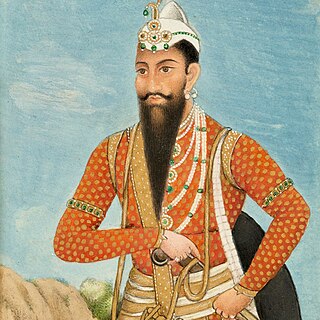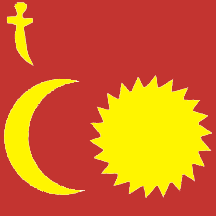The Hill States of India were princely states lying in the northern border regions of the British Indian Empire.

Baghal - Arki was one of the Princely states of India during the period of the British Raj. It covers an area of 312 square kilometres (120 sq mi) and is now part of Arki Tehsil in Solan District of Himachal Pradesh state. Baghal was founded by Rana Aje De in 1310-40 and was acceded to India on 15 April 1948. The capital of Baghal - Arki.
Pratap Singh may refer to:

Shrimant Maharaja Sir Pratap Singh Rao Gaekwad, who belonged to the Gaekwad dynasty of the Marathas, was the ruling Maharaja of Baroda. He succeeded to the throne upon the death of his grandfather Sayajirao Gaekwad III in 1939. In 1947, British India was partitioned into two independent dominions, and Pratap Singh acceded his state to the Dominion of India. By 1949, Baroda had been merged into India.
Pratapsingh may refer to:
Devi Garh Palace is a heritage hotel and resort, housed in the 18th-century Devi Garh palace in the village of Delwara. It was the royal residence of the rulers of Delwara principality, from the mid-18th century till the mid-20th century. Situated in the Aravalli hills, 28 km northeast of Udaipur, Rajasthan, Devigarh forms one of the three main passes into the valley of Udaipur.

Kharak Singh was the second Maharaja of the Sikh Empire. He was the eldest son of Maharaja Ranjit Singh, founder of the Sikh Empire and his consort, Maharani Datar Kaur. He succeeded his father on 27 June 1839 and reigned until his dethronement and imprisonment on 8 October 1839. He was succeeded by his only son Nau Nihal Singh.

Barwani State was a princely state in India. The seat was at Barwani.

Mandi State was a native state within the Punjab, later the Punjab States Agency, with the town of Mandi as its capital. The state of Mandi, which included two towns and 3,625 villages, was part of the States of the Punjab Hills. It was located in the Himalayan range, bordering to the west, north, and east on the British Punjabi district of Kangra; to the south, on Suket; and to the southwest, on Bilaspur. As of 1941, population of Mandi State was 232,598 and area of the state was 1,139 square kilometres (440 sq mi).
Events in the year 1837 in India.

Kanker State was one of the princely states of India during the period of the British Raj. Its last ruler signed the accession to the Indian Union in 1947.
This article details events in the year 1840 in India. Occurrences include the establishment of the Bank of Bombay, and the fall of the Maqpon dynasty.
This list details events in the year 1838 in India. Major events include the Agra famine of 1837-38, and the founding of the Times of India on 3 November.
Events in the year 1851 in India.

Raja Dhian Singh was the longest serving wazir of the Sikh Empire, during the reign of Maharajah Ranjit Singh, and four of his successors. He held the office for twenty five years, from 1818 up till his death. Dhian Singh was a brother of Raja Gulab Singh of Jammu, who later founded the Dogra dynasty when he became Maharaja of the princely state of Jammu and Kashmir under the British Raj. Another brother Suchet Singh also served the empire. The three brothers were collectively known as the "Dogra brothers" in the Sikh empire, based on their ethnicity.







